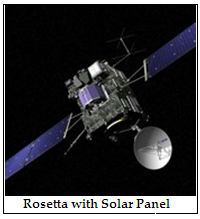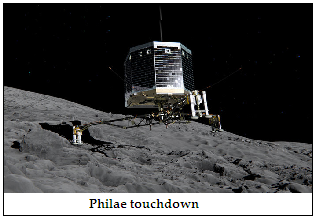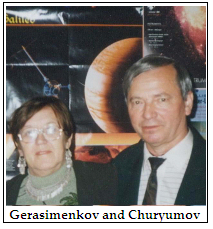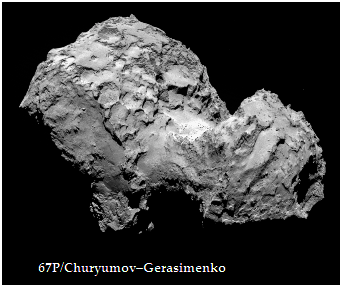First results are in from European Space Agency’s Rosetta space mission, says S.Ananthanarayanan.
Robotic space probe, Rosetta, was launched in March 2004, and ten years later, on 10th Sep 2014, it reached its destination, to be in orbit around comet 67P/Churyumov–Gerasimenko. The decade-long project was a combined effort of European scientists, with Germany, Switzerland, Italy and France providing some of important equipment that the probe carries. Rosetta, after settling into the orbit, sent a landing craft, Philae, down to the surface of the comet, which is a feat by itself, as the comet is just over 4 km long and wide and exerts barely any force of gravity. The Philae craft has unfortunately landed into a shaded place, and it is only later that its solar panels can get active and enable Philae’s scientific work to be resumed. But some work was done while Philae’s power lasted and Rosetta has transmitted a great deal of data during the many months that it has been in great proximity of the comet.


Comets and asteroids
Comets and asteroids are regarded as the remnant fragments of the material from which the Solar System was formed. While the large planets formed through accretion of material of the dust cloud, or the nebula, that surrounded the newly formed sun, part of the material was left out and remained as bits and pieces in orbit. One group of these smaller bodies is found in an orbit just after the terrestrial, or rocky planets, that is after Mars and before Jupiter, as the asteroid belt, and another group is distributed further out, after Neptune, as the Kuiper belt. And then there are the distant, icy bodies, called the Oort cloud, that also orbit the sun, extending as far as half-way to the nearest star. Asteroids and comets are generally small objects, with dimensions of just a few meters, and mostly not more than a few hundred metres. Being low mass bodies, gravitational forces are weak and the masses have not collapsed into spheres, and have irregular shapes.
Comets generally have elongated orbits and take many years, even millions of years, for each time round. Comets appear to have originated from the more distant Kuiper belt, as a result of gravitational disturbances that nudge objects into elongated orbits. As comets spend so much of their lifetime in very cold, distant space, gases that form part of their composition remain as ice and are not lost by evaporation into space. Except that when comets come down to quickly pass nearest the sun, they warm up and some of the ice sublimes, to create a thin atmosphere, called the coma. The coma scatters light and even the smaller of comets then become visible, as a bright blob in the sky, for a few weeks or months that the comet stays near the sun. The gaseous matter, in fact, is ‘blown back’ by the pressure of sunlight, and this forms the characteristic plume, or ‘tail’, of comets. And part of the gases of the coma also escape, and take some solid, but fine, dust along with them. This feature, of the coma and tail, is the mark that distinguishes comets from asteroids. But there are also some asteroids that have elongated orbits, and there are comets which seem to have lost all their icy content, which has reduced them to be regarded as asteroids.
As comets are found to have substantial water content, it is one view that much of the water we find in the oceans came from comets which crashed into the earth billions of years ago. Comets have even been found to contain organic molecules, which leads to the possibility that some precursors of life may have come to the earth riding on comets or meteorites. It has also been suggested that the impact of rocky and icy objects, like comets, could lead to the synthesis of amino acids, which could then assemble into proteins.
Rosetta's host comet<
The comet, 67P/Churyumov–Gerasimenko, which originated in the Kuiper belt, is a dumbbell shaped rocky object, 4.1 and 4.3 km at its longest and widest, and goes around the sun once in 6.45 years. The comet also rotates, about once every 12.4 hours, and is speeding up, to reach 1,35,000 kmph in Aug 2015, when it would be closest to the sun. The comet was discovered in 1969 by Russian astronomers, Klim Ivanovich Churyumov and Svetlana Ivanova Gerasunenko, and is named after them, following the convention.

After the first probes sent out during the 1986 visit of Halley’s comet, ESA and NASA planned extensive projects to visit and bring back samples of comet material. But budget constraints hampered these schemes and what materialized was the Rosetta mission, which is of comet rendezvous, escort, and in situ investigation by sending down a lander craft. Particularly significant is the role of Rosetta in flying alongside the comet as it approaches the sun and witnessing how the warmth of the sun transforms the comet’s frozen content to create the coma. Although the path of the comet was known from telescope observation, the surface topography was not. It was while in orbit around the comet that Rosetta mapped and selected suitable sites for Philae to land. And in the process, Rosetta collected unprecedented detail of the construction, composition and dynamics of comets.

One of the first things noticed that the comet has a very low albedo, which means that it reflects very little of the light that falls upon it. This is largely because of the dust and carbon-rich material that covers the surface, with almost no areas that could consist of ice. But as the comet approaches the sun and gets warmer, jets of gas, mostly water, but also a lot of carbon monoxide or carbon dioxide have been found streaming out. This suggests that there is frozen material below the dusty surface and protected by the surface. The flow of gases also mobilizes dust and the coma is found to consist by weight of much more dust than gas. Protrusions on the surface of the comet also collect dust that is blown by the gas ‘wind’.
The other remarkable observation is that the emission of gases is not steady but varies, in quantity and composition, as the comet turns round on its axis and also changes its orientation as it moves closer to the sun. This indicates that there is variation in the nature of the surface and also the substratum at different places. The topography of the comet has now been charted in some detail and it is becoming possible to identify the out-gassing behavior of different regions. The shape of the comet itself is like a dumbbell, or with two lobes connected by a neck. One possibility is that the neck is due to greater erosion or loss of matter in that part. But another likely reason is that the comet arose with two separate fragments coming together. Marked difference in the gas emitting activity of either lobe would indicate a third possibility, of the two fragments that came together having different composition, which would suggest that there has been ‘migration’ of orbiting material.
But a significant discovery is that the content of the ‘heavy’ hydrogen isotope in the water on the comet does not correspond to water found on the earth. This rules out this category of comets, at any rate, as the source of the water on the earth. But Philae, in the short time while battery power lasted, did detect the presence of organic molecules in the thin atmosphere of the comet.
Rosetta would shepherd the comet all the way to its closest approach to the sun in Aug 2015 and then while the comet moves away. And along the way, Philae, which is right on the comet surface, would become operational and there would be even more information of what the comet is made of. As comets are believed to be the primordial raw material from which the solar system formed, understanding comets would enrich our understanding of the origin of planets and possibly, geological processes.
------------------------------------------------------------------------------------------